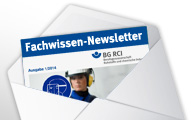Chapter 6.3.2: Ductless filtering fume enclosures
Ductless filtering fume enclosures must be designed and operated in such a way that no hazards occur. These devices are normally only intended for working with small quantities and are not suitable for work with highly toxic, carcinogenic, mutagenic or reprotoxic materials or with materials that have low boiling points (≤ 65 °C). In order to ensure the retention capacity of the filters, they require very careful maintenance and specialist knowledge on the part of the user.
See also Section 6.3.1 for hazards.
Ducteess filtering fume enclosures (also: recirculating air extraction system with filters, circulating air extractors) cannot generally replace driven-air fume hoods systems as per DIN EN 14175. They are to be equipped with suitable filter systems. Since the exhaust air is vented into the laboratory, particular attention must be paid to securing adequate cleaning of the ambient air to ensure occupational safety. In this vein, reference is made to the operator's obligation to determine levels and comply with defined limits, also when using extraction boxes with air return. The operator must also demonstrate the suitability of the facilities used within the scope of a risk assessment. Reliable manufacturer statements regarding substances tested with extraction boxes that employ air return can be incorporated in the risk assessment when evaluating suitability. If permanent compliance with the limit values cannot be reliably determined using the characteristics assured by the manufacturer, compliance must be demonstrated separately in application of the Technical Rules for Hazardous Substances (TRGS) 402. Irrespective of manufacturer certificates, the operator is responsible for maintaining a safe working environment, in particular complying the Occupational Health and Safety Act (ArbSchG), Operational Safety Ordinance (BetrSichV) and Ordinance on Hazardous Substances (GefStoffV). All prohibitions relating to recirculation of exhaust air containing CMR substances as per § 10 (5) of the Ordinance on Hazardous Substances (GefStoffV) must be observed.
Special expertise is required on the part of users, in particular to avoid filter overloading.
Within the scope of the risk assessment, particular attention must be paid to determine whether reliable measures are in place to handle the following hazards and potential incidents:
- Potential additional fire loads due to charged or uncharged filter materials, such as activated carbon
- Risks of fire and explosion when handling flammable liquids
- Ignition of explosive atmospheres in the air circulation system
- Spontaneous combustion of filter materials due to load
- Exposure by inhalation to toxic substances and substances that are sensitising to the respiratory system
- Exposure to new, unknown or not adequately tested substances
- Effect of continuous reactions
- Effects of failing substance containers in the event of pressure reactions
- Effects of implosions in the event of a vacuum
- Effects of fragments and splashes.
In addition to this, the following must be secured:
- Compliance with the occupational exposure limit and acceptance/tolerance concentrations in the ambient air
- The retention capacity of the filter is appropriate for the hazardous substances and intended application, and any breakage is both reliably detected and indicated via an alarm
- The hazardous substances already adsorbed cannot be desorbed again as a result of interactions with other substances, e.g. solvents with low boiling point or water vapor
- Hazardous substances already adsorbed cannot be desorbed again as a result of an impermissible rise in temperature
- Safety devices such as sensors are operational and their function is reliably maintained
- Inspection, maintenance and regular tests are performed (type, interval and scope, qualified person) to secure the safety of the equipment
- Filters can be changed reliably and safely without any contamination or exposure.
Since the absorption capacity of the filters is limited, only sufficiently small amounts of substances may be handled to ensure complete absorption of the substances released at all times, also in the event of damage.
Even in the event of damage, fragment and splash protection must remain intact and it must be possible to perform inner rinsing safety to prevent risks of explosion. When bombarded with a different material, substances adsorbed by the filters can potentially be desorbed and released again within a short space of time, depending on their quantity and also the strength of the interaction occurring. Regular maintenance and scheduled filter changes are indispensable. Additional hazards can occur during filter changes and when fires occur in filters.
See DIN 12927 "Laboreinrichtungen – Absaugboxen mit Luftrückführung – Anforderungen, Prüfungen".
For information on the requirements when using safety cabinets with air return for work with carcinogenic or mutagenic cytostatic agents, please refer to the approach recognised by the respective authorities in Germany as per § 10 (5) of the Ordinance on Hazardous Substances (GefStoffV) in Merkblatt M 620 "Sichere Handhabung von Zytostatika" published by the German Social Accident Insurance Institution for the Health and Welfare Services/DGUV Information 207-007 "Zytostatika im Gesundheitsdienst – Informationen zur sicheren Handhabung von Zytostatika", as well as DIN 12980 "Laboreinrichtungen – Sicherheitswerkbänke für Zytostatika".







